The List View displays the summary of the OneDrive information from the source and target tenants. Initially, the List View displays the list of accounts and other columns are blank. As you run the discovery, collect statistics and migration tasks, the list view will display more information about the accounts and the state of the OneDrive migrations.
To open the List View, open the Accounts and User Data migration workspace. Then select the OneDrive tab and then select List View if not already selected.
The List View has several predefined filters to help you search for accounts based on OneDrive account information:
- Last Run Status - returns a list of OneDrive accounts based on the status of the latest task. See the Last Run Status column description below for filter values.
- Migration State - returns a list of OneDrive accounts based on the migration state of the OneDrive. See the Migration State column description below for filter values.
- Account Matching - returns the list of OneDrive accounts that are either Matched or Unmatched.
- Collect Statistics Status - returns a list of OneDrive accounts based on the state of the Collect Statistics task for the OneDrive account. See the Collect Statistics column description below for filter values.
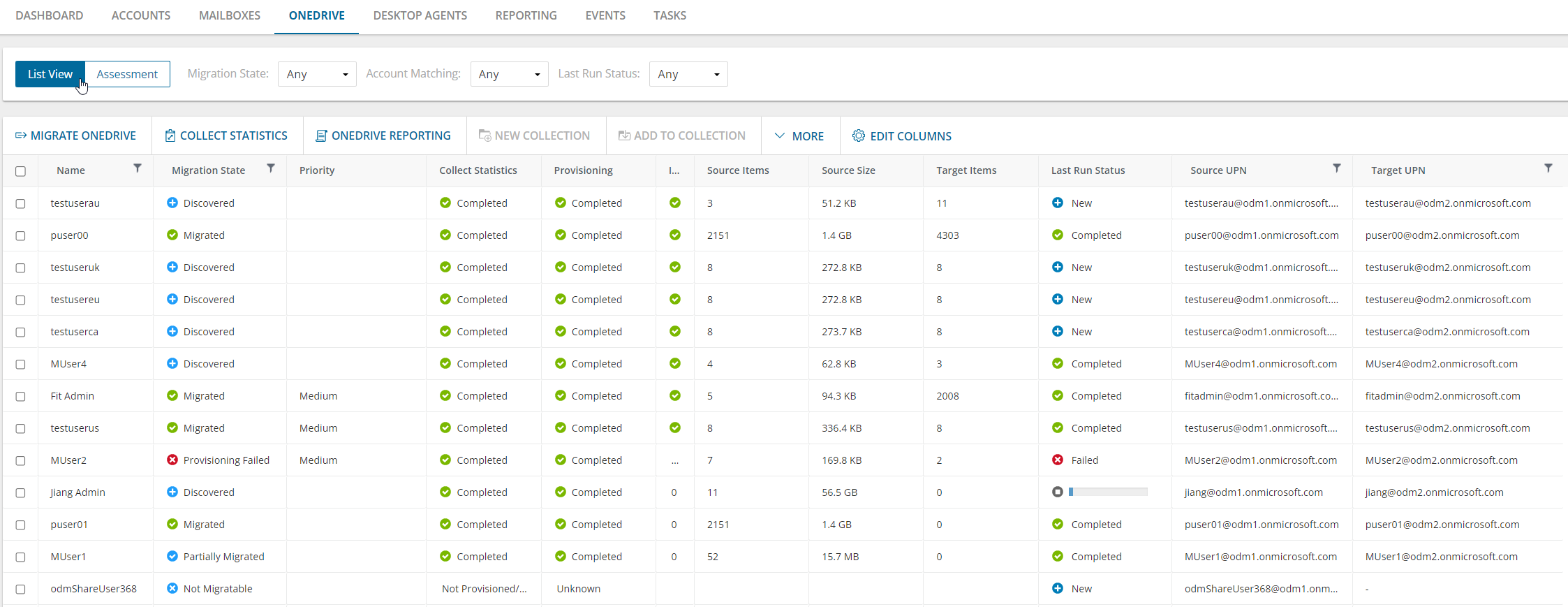
The columns in the List View are as described below. Use the Edit Columns List View Actions Menu to show or hide columns in the list:
- Name - name of the account in the source tenant.
- Migration State - indicates various stages in the migration process.
- <blank> - no task has been run yet. Use Unknown in the filter.
- Discovery Failed - failed to retrieve source site or statistics data, or other errors occurred.
- Discovered - retrieved statistics from source.
- Not Migratable - source has no license or OneDrive not provisioned.
- Provisioning - started provisioning OnDrive in the target tenant.
- Provisioning Failed - OneDrive provisioning failed due to license or credential errors.
- Provision Pending - no provisioning errors, but OneDrive not provisioned after 1 hour. Customers must rerun the migration task within 24 hours or manually provision the target
- Provisioned - OneDrive provisioned and verified in target tenant.
- Queued - task is waiting for migration service resources to be available. For more information, see How Queuing Works.
- Migrating - source and target tenants analyzed and migration started.
- Migration Failed - critical error occurred nothing has been migrated. See task event details for more information.
- Migrated with Issues - some content is migrated but errors or warnings were encountered during migration. Use a reporting task to look for missing files or other errors.
- Partially Migrated - migration is successful, but source item count is larger than target item count after migration. See task event details for more information.
- Migrated - OneDrive migrated successfully to the target tenant.
- Collect Statistics - the state of the Collect Statistics task for the OneDrive account. An empty value indicates that the account has not yet been assessed. Accounts that were an assessment was attempted will display a status as described below. You can filter the table by selecting one of the following values in the Collect Statistics Status filter. Click Clear All to reset the filter if necessary.
- Completed - OneDrive is provisioned and the statistics were collected successfully.
- Not Licensed/Provisioned - OneDrive is neither licensed nor provisioned and the statistics could not be collected.
- Unavailable - the named account is not available and the statistics could not be collected.
- Not Started - collection of statistics has yet to be attempted for the named account.
- Provisioning - when OneDrive is provisioned for the user on the target, the value is set to Completed.
- Items Migrated (%) - percentage of files that have been migrated to the target
- Source Items - number of items in the OneDrive for the source account. If there is no value the account has not yet been assessed.
- Source Size- total size of all the files in OneDrive for the source account. If there is no value the account has not yet been assessed.
- Source Last Modified - indicates the date and time of the last modification of the source OneDrive. Every time the statistics or migration task is run this value will be updated according to the source date.
- Target items - number of items in the OneDrive for the target account. If there is no value, you did not select the option in the New OneDrive Collect Statistics Task wizard to collect item count statistics from the target account, the account is not available, OneDrive has not been provisioned or the account has not yet been assessed.
- Last Successful Run - date and time of the last successful migration. This column is hidden by default.
- Last Run Status - indicates the status of the latest task. Valid values are New, In Progress, Completed, Failed, or Stopped..
- Source UPN - User Principal Name (UPN) of the source account.
- Source Root Url - relative path of the source OneDrive root URL.
- Target UPN - User Principal Name (UPN) of the target account.
- Collections - indicates the most recent collection where the corresponding account is added and the number of additional collections that also contain this object.
OneDrive Details
When you select an account from the List View, the OneDrive Detail pane opens. The information in the pane is described below. Some properties may not appear in the screenshot because they are relevant to specific situations.

-
- View AI Summary - This link is available if you opted for the AI feature in the organization you created (see Organizations and Regions), and the task is a migration task that supports the AI migration assistant and you selected the Generate AI summary option in the Reporting step of the migration wizard. Click this link after the task has completed, to view the AI-generated migration summary.
|

|
NOTE: The View AI Summary link may take a while to appear depending on the volume of tasks and objects being migrated. If this is the first time you have selected this option, the Quest Policies prompt appears. Read the Quest AI Terms of use and click Accept to proceed. This s a one-time acceptance prompt and your acceptance covers all migration tasks that support the AI migration assistant. |

- Source Email - email address of the selected account in the source tenant.
- Target Email - email address of the selected account in the target tenant.
- Provisioning - when OneDrive is provisioned for the user on the target, the value is set to Completed.
- Migration Progress (%) - percentage of files that have been migrated to the target.
- Source Items - number of items in the OneDrive for the source account. If there is no value the account has not yet been assessed.
- Target items - number of items in the OneDrive for the target account. If there is no value, you did not select the option in the New OneDrive Collect Statistics Task wizard to collect item count statistics from the target account, the account is not available, OneDrive has not been provisioned or the account has not yet been assessed.
- Last Run Status - indicates the status of the latest task. Valid values are New, In Progress, Completed, Failed, or Stopped..
- Last Successful Run - date and time of the last successful migration. This column is hidden by default.
- Events - count of the events that occurred during OneDrive processing through one or more tasks.
- Collections - list of collections that contain the corresponding account.
- Tasks - list of tasks invoked for the selected OneDrive.
See the topic Managing Accounts with Collections. The actions and steps described in the topic are the same for managing Mailboxes accounts with collections.
The Collect OneDrive Statistics Task conducts an assessment of OneDrive related to all accounts in the source tenant and matching accounts in the target tenant: The assessment report provides the following information among others:
- The number of items in the OneDrive for each account and the total number of items across all selected accounts where the assessment was possible.
- The total size of all the items in the OneDrive for each account and the total size of all items across all selected accounts where the assessment was possible.
Each Collect OneDrive Statistics Task generates events. Events are milestones that a task achieves as it runs. For example, when a Collect OneDrive Statistics Task starts, an event is logged and it appears in the events list. When the number of accounts that are selected for assessment is large, the Collect OneDrive Statistics Task divides the total number of accounts into manageable sets. Each set is called a batch. When a batch of accounts is assessed, another event occurs.
|

|
NOTE: Before you proceed, verify that the source tenant accounts have been discovered. For more information see Discovering Accounts |
In this topic:
Starting a Collect OneDrive Statistics Task
- Log in to Quest On Demand and choose an organization if you have multiple organizations.
- From the navigation pane, click Migrate > Projects to open the My Projects list.
- Create a new project or open an existing project.
- Click the OneDrive tile, or click Open from the OneDrive tile to open the Accounts and User Data dashboard.
- Select the OneDrive tab and then select List View if not already selected. Then select any account in the list to activate the menu options.
- Click Collect Statisticsfrom the Actions ribbon. The New Collect OneDrive Statistics Task wizard starts. Each step is described below:
- Description
|

|
NOTE: Statistics are collected from the source tenant by default. |
- Include collection of item count from target OneDrive accounts - select this option to include item count statistics from the target account and generate the Comparison Report.
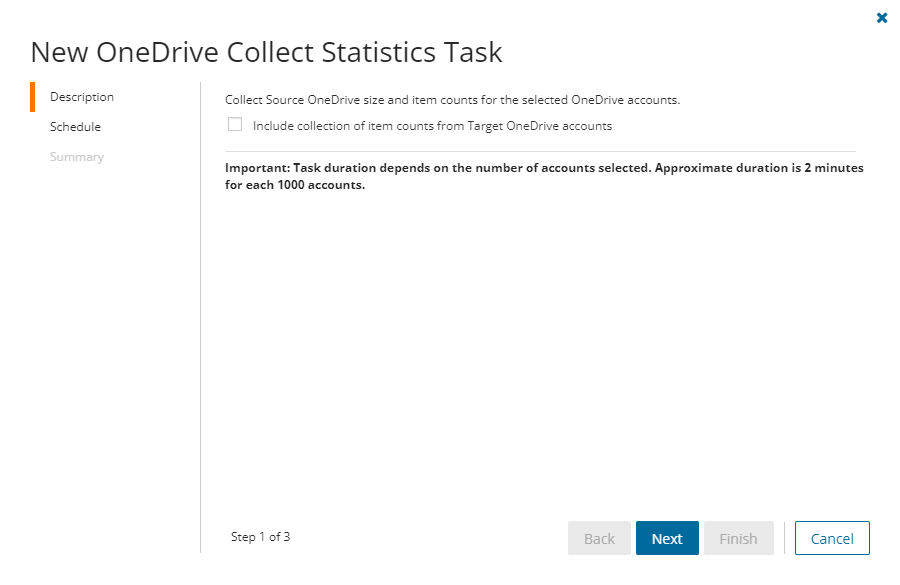
- Click Next
- Schedule
- Choose from one of three options to schedule the task. The scheduler will be activated only after you complete the task wizard.
- Run now - task runs immediately.
- Run later - task must be started manually.
- Schedule - task will be started at a future date and time entered in the corresponding calendar field.
- Click Next.
- Summary
- Verify the task specifications as described below:
- Name - name of the task. You can specify a custom name. The default name is Collect OneDrive Statistics Task.
- Source tenant - name of the tenant where the statistics will be collected.
- Target tenant - name of the target tenant in this project.
- Collect target statistics - indicates whether you have opted to include item count statistics from the target account.
- Scheduled start - date and time when the task will start. Now indicates that the task will start immediately.
- Click Back to revise or review a previous step or click Finish to complete the task wizard and start the task as scheduled.
Reviewing the Collect OneDrive Statistics Task
- Open the Tasks tab.
- Select the Collect OneDrive Statistics Task that you want to review.
- In the task detail pane that opens, the information presented is as described below:
- Type - Type of the task. The type is OneDrive Assessment.
- Created - Date and time when the task was created.
- Modified - Date and time when the task was last updated.
- State - State of the task.
- Last Operation - The action that was most recently performed in this task.
- Schedule - Date and time when the task started. Now indicates that the task started immediately after the task was created.
- Accounts (number) - number indicates the count of accounts in the source tenant that are inspected. The values indicate the assessment category of the accounts. The categories are:
- Completed - Number of accounts where OneDrive is provisioned and the total size and item count was successfully assessed.
- Stopped - Number of accounts where OneDrive could not be assessed because it is neither licensed nor provisioned.
- Events (number) - The number of events that the task encountered.
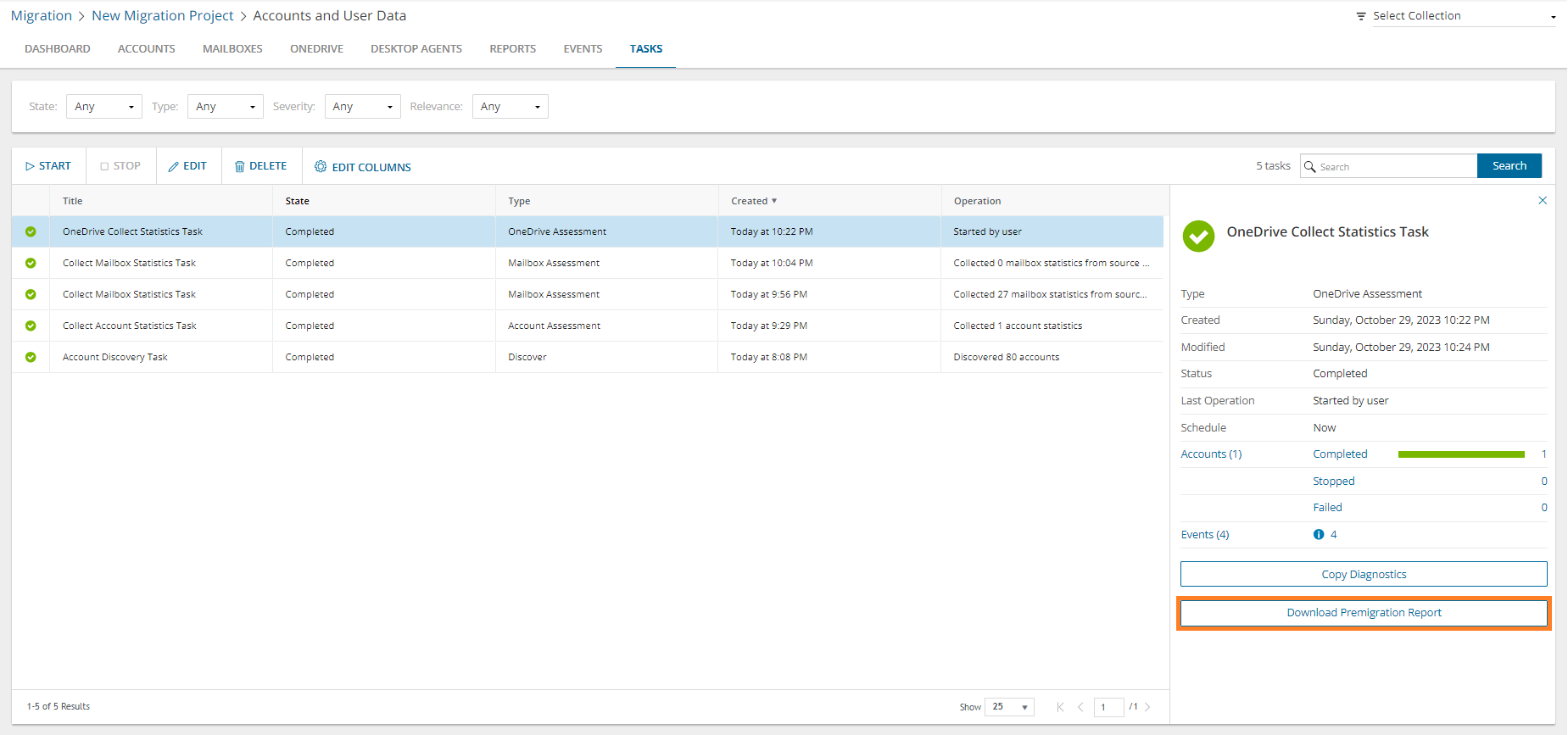
Reviewing the statistics collected
- Open the Tasks tab.
- Select the Collect OneDrive Statistics Task that you want to review.
- From the task detail pane, click Download Premigration Report. If comparison reports were generated, click Download comparison report.
- Download and save the ZIP file to a suitable folder, and extract the report.
Reviewing the events for the task
- Open the Tasks tab.
- Select a task named Collect OneDrive Statistics Task that you want to review.
- In the task detail pane that opens, click Events (number). The Events tab opens with a filtered list of events for the selected task.
- Select an event that you want to review. In the task detail pane that opens, the information presented is as described below:
- Object - name of the account if applicable.
- Task - name of the task.
- Time - date and time when the event occurred.
- Category - type of task. the value is OneDrive Assessment.
- Summary - a descriptive statement about the event. Notice that the most recent event provides a summary of the assessment across all accounts that could be assessed. The assessment details contain the Total items count and Total file size from the source, and the Total target items count from the target tenant if data is available.

You can migrate OneDrive for discovered and matched accounts with large selection of migration options. These options give you control over the scope of files migrated, permissions, licensing and version management
In this topic:
Recommendations
The OnDemand migration service for OneDrive attempts to provision OneDrive for accounts being migrated if the OneDrive has not been provisioned. You can manually provision the OneDrive before a migration as described below:
- Provision OneDrive for accounts in the target tenant that don't have a OneDrive provisioned.
- OneDrive must be provisioned at least 24 hours before starting a migration.
Starting a OneDrive Migration Task
- Log in to Quest On Demand and choose an organization if you have multiple organizations.
- From the navigation pane, click Migrate > Projects to open the My Projects list.
- Create a new project or open an existing project.
- Click the OneDrive tile, or click Open from the OneDrive tile to open the Accounts and User Data dashboard.
- Open the OneDrive tab and verify that the List View has displays the list of user Accounts. See Discovering Accountsif the list is empty.
- Select one or more accounts for which you migrate the OneDrive contents. This enables the Migrate OneDrive menu option.
|

|
NOTE: To migrate OneDrive for user accounts in a collection
- Select the collection from the dropdown menu in the top right corner labeled Select Collection.
- Select the accounts to migrate from the collection. To check all accounts, select the check box in the list header.
- Proceed to the next step.
|
- Click Migrate OneDrive to open the New OneDrive Migration Task wizard and follow the steps described below.
- Start
- Use the settings from an existing migration template for this task - select this option if you have already saved a previous migration templates. if this is the first time you are migrating mailboxes, keep this option unchecked.
- Select template - select a template that you previously created, from the dropdown list.
- Go to Summary step - select this option to preserve the settings and go directly to the last step of the wizard. If you do not select this option, but you have selected a template, you can step through the wizard and edit the settings in the template.
- Click Next.
- Migration Options
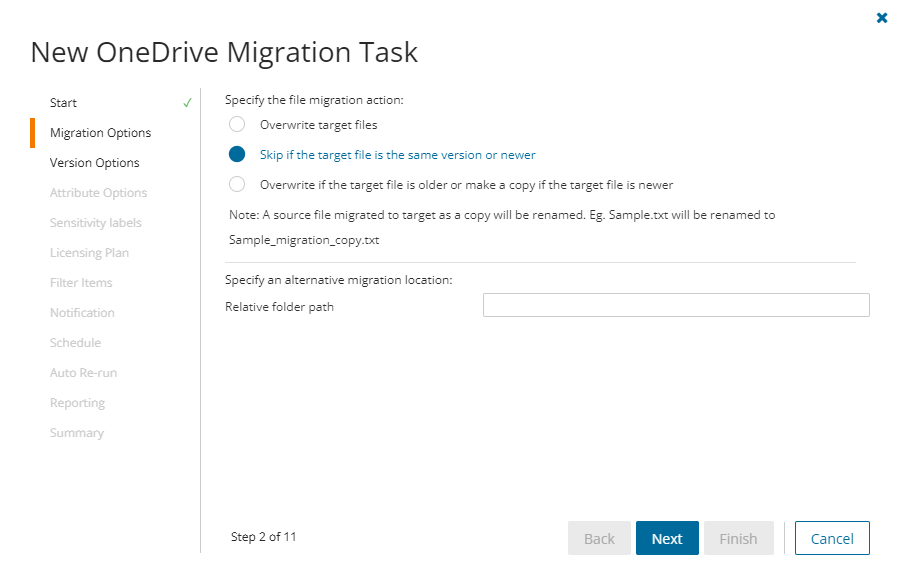
- Choose a migration action
- Overwrite target files - Select this option to overwrite the file in the target tenant if it was previously migrated.
- Skip if the target file is the same version or newer - This is the default selection. When this option is selected, the migration service will not migrate a file if the file already exists on the target tenant and has the same or newer version than the file in the source tenant. Select this option to speed up the migration process especially if you are starting multiple migration tasks.
- Overwrite if the target file is older or make a copy if the target file is newer - Select this option to overwrite the file in the target tenant if it was previously migrated and the file in the target is an older version, or create a copy of the source file if it was previously migrated and the file in the target is a newer version. When a copy is created in the target it will be renamed. For example, Sample.txt will be renamed to Sample_migration_copy.txt. If the file versions in the source and target are the same, it is skipped.
|

|
NOTE: Do not rename a previously migrated file or folder before the migration completes. If you rename a previously migrated file or folder before the migration completes, it may be unexpectedly overwritten even though you select the second or third option. New files or folders are not impacted. The migration service compares both file versions and modified date to determine older or newer files. |
- [Optional] Files are migrated to the root folder. You can specify an alternate target migration folder
- Relative folder path - specify the relative path to a folder where the OneDrive contents will be migrated.
- Click Next.
- Version Options
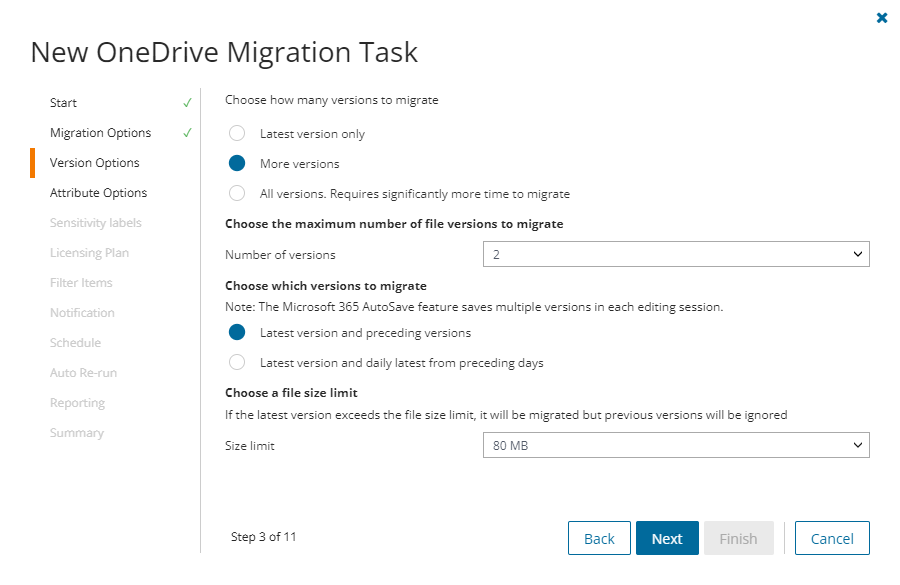
- Specify the scope of file migration
Each OneDrive file has its own version history and each change to a file is saved with a new version. Select from the following migration options to determine how file versions should be migrated:
|

|
NOTE: Only the latest version of frequently updated files such as outlook PST files, database files and log files will be migrated |
- Latest version only - This is the default selection. The most recent version of the file will be migrated. All other versions will be ignored.
- More versions - Additional versions of a file will be migrated based on the options described below. Large version sets take a significantly long time to migrate.
- Number of versions - the maximum number of version to migrate. The available choices are: 2, 5, 10, 30, 60, 90 and 365. When you specify the number of versions, additional options can be selected.
- Latest version and preceding versions - The version count includes the latest version and the preceding versions in chronological order restricted to the Size Limit of the latest version. For example, if you choose to migrate 5 versions, then the most recent version and 4 preceding versions will be migrated as long as the most recent version does not exceed the selected size limit specified.
- Latest version and daily latest from preceding days - The version count includes the latest version and the latest version from each preceding day restricted to the Size Limit of the latest version. For example, if there are many versions of a file and you choose to migrate 5 versions, then the most recent version and the latest version from each of the 4 preceding days will be migrated as long as the most recent version does not exceed the selected size limit specified.
- Size limit - This setting is available if the Latest version and preceding versions or the Latest version and daily latest from preceding days option is selected. By default, the size limit is 80 MB. You can configure the size limitation by selecting from one of the possible values in the dropdown list. If the size of the latest file version exceeds the selected size limit, the latest version will be migrated and previous versions will be ignored. If the size of the latest file version does not exceed the selected size limit, then the file and its versions will be migrated based on your selection between Latest version and preceding versions or Latest version and daily latest from preceding days.
- All Versions - The latest version of the file will be migrated, and all previous versions of the file will be migrated if the latest version does not exceed a specified size limit. This option requires significantly more time to migrate all the versions.
- Size limit - This setting is available if the All Versions option is selected. By default, the size limit is 80 MB. You can configure the size limitation by selecting from one of the possible values in the dropdown list. If the size of the latest file version exceeds the selected size limit, the latest version will be migrated and previous versions will be ignored. If the size of the latest file version does not exceed the selected size limit, then the file and its versions will be migrated.
- Click Next.
- Attribute Options
This step determines how file and folder attributes are migrated and managed by the migration service.

- Account display: Select which account will be displayed in the Created by and Modified by properties of migrated content:
- System Account - This is the default selection. The Created by and Modified by properties of the migrated file or folder is displayed as System Account.
- Matching target account - The Created by and Modified by properties of the migrated file or folder is displayed as the target account that was matched with the source account. If the target account cannot be found, the migration service records a warning event and the properties of the migrated file or folder is displayed as System Account.
- Permission migration: Select how the sharing permissions will be transferred to the target users:
- Do not migrate permissions - This is the default selection. Permissions associated with the file being migrated will be ignored.
- Update permissions for migrated content - The permissions of files that are migrated will be updated. Some files may be skipped if you selected the Skip if the target file is the same version or newer in the previous step. Sharing Links are not migrated unless Convert Sharing Links permissions to direct permissions is selected.
- Update permissions for all content - All file or folder permissions in the target tenant will be updated whether or not they were migrated if the corresponding file or folder is present in the source tenant. Sharing Links are not migrated unless Convert Sharing Links permissions to direct permissions is selected.
- Auto rerun: Select whether to migrate permissions with the Auto rerun task to reduce the task load
- Migrate permissions with the Auto rerun task - the permissions will be migrated with the Auto rerun task after the migration completes.
- Permission conversion
- Convert Sharing Links permissions to direct permissions - migration is slower with this option select. Select this option to convert Sharing Links permissions of files or folders in the source tenant to direct permissions in the target tenant. Only shared links that were activated by the users or group members (the user or group member clicked on the link to access the file or folder) in the source tenant will be migrated and converted to direct permissions. Users or group members who did not activate a shared link in the source tenant will not get the direct permissions in the target tenant and must re-request permissions from the owner when they access the file or folder in the target tenant.
|

|
NOTE:
- Users can access their shared content through the Shared With Me view in OneDrive. Some restrictions apply.
- Some sharing permissions are not converted if the user has shared the file or folder with more than 30 users. Only 30 users will receive direct permissions from the Sharing Links, while others will not be processed due to a Microsoft limitation.
- If a Sharing Link permission is removed on the source file or folder after it is migrated, the links to this file or folder are still visible in the Shared with me and Shared by me views in OneDrive, but the file or folder cannot be accessed.
- Group permissions are not displayed in the Shared with me view because Microsoft currently does not support this functionality.
- For shared folders, only the top level folder is displayed in the folder tree.
- For files and folders that do not exist in target tenant before migration the source permission will always be used.
- For files and folders that exist in the target tenant before a migration, the following example describes how file sharing permissions will be managed. The rules are the same for internal and external users as permission holders, or groups (Microsoft 365 group or security group) as permission holders.
For files
If Overwrite target files for selected migration is selected, the source file sharing permission will be used.
If Skip if the target file is the same version or newer is selected, the target file sharing permission will be used.
For folders
If either Overwrite target files for selected migration or Skip if the target file is the same version or newer option is selected, the target sharing permission will be used as a base. Any addition of permissions in the source will be added onto the target. |
- Click Next
- Sensitivity Labels
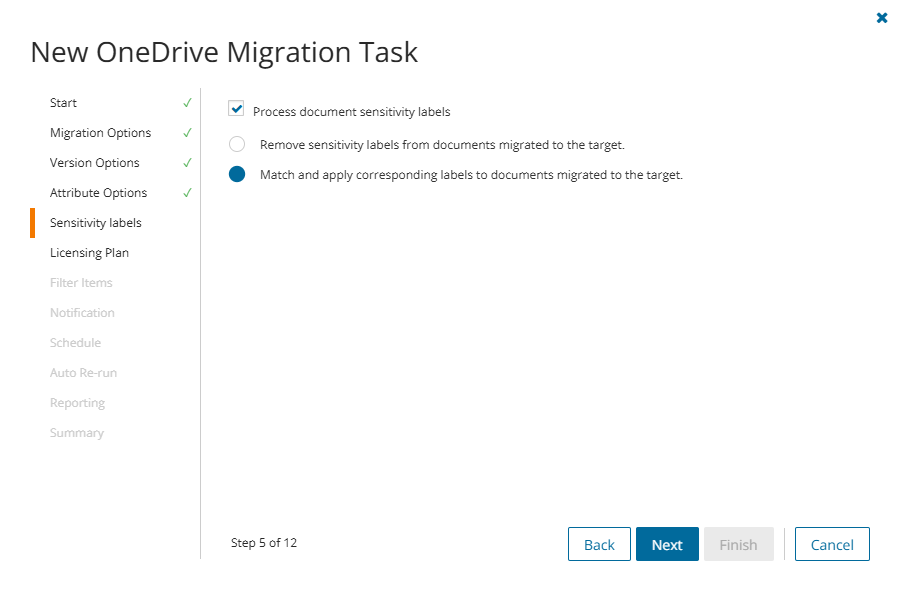
Choose how you want to migrate sensitivity labels applied to OneDrive files. Sensitivity labels require specific tenant permissions. They must be discovered and matched before you can use the following options. OneDrive migration can only migrate the latest file version when the sensitivity label option is selected. Older versions will be migrated without the label applied. For more details, see the topic Sensitivity Labels.
- Process document sensitivity labels - select this checkbox to enable sensitivity label processing if you have already configured and matched sensitivity labels.
|

|
Caution: Encrypted documents may be inaccessible on the target tenant if sensitivity labels that are applied to documents in the source tenant are not processed. If a document is encrypted in the source, then it is decrypted, labels are processed and the document is reencrypted in the target. |
- Remove sensitivity labels from documents migrated to the target - select this option to clear the labels from migrated documents. Labels on documents in the source tenant are not changed.
- Match and apply corresponding labels to documents migrated to the target - select this option to match and apply sensitivity labels during migration. If the label in the source document has a matching label in the target (there is a corresponding target label in the On Demand repository), the source label is replaced by the target label. If the label in the source document has no matching label in the target (there is no corresponding target label in the On Demand repository), the document is not migrated.
- Click Next.
- Licensing Plan
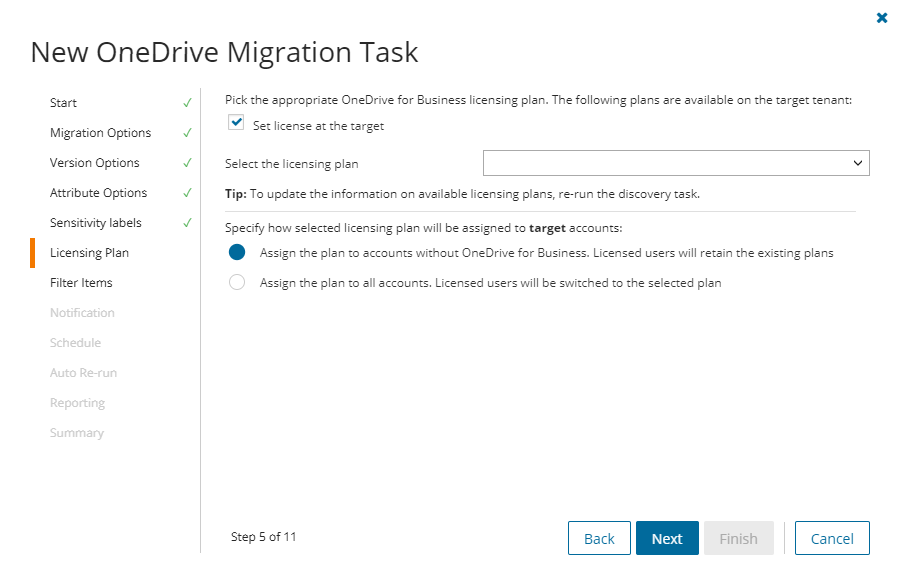
- Set license at the target - select this check box to assign a selected license to migrated mailbox accounts in the target tenant. Clear the check box to skip license assignments for migrated mailbox accounts.
- Select the licensing plan - this dropdown list appears if the Set license at target check box is checked. Select the licensing plan from the dropdown list that you want to assign to migrated mailboxes.
- Specify how the selected licensing plan will be assigned to the target accounts:
- Assign the plan to accounts without Exchange Online option. Licensed users will retain the existing plans - Retain the existing licenses and assign the selected plan only to unlicensed accounts (default). Licensed users will retain the existing plans.
- Assign the plan to all accounts. Licensed users will be switched to the selected plan - Replace all license assignments with the licenses from the selected plan. Licensed users will be switched to the selected plan.
|

|
NOTE:
- OneDrive for Business that have not been licensed on the source tenant will retain the unlicensed status in the target tenant.
- Selected licensing option is only applicable to OneDrive migration. It does not affect the licensing plans picked for Mail Migration.
|
- Click Next.
- Filter Items
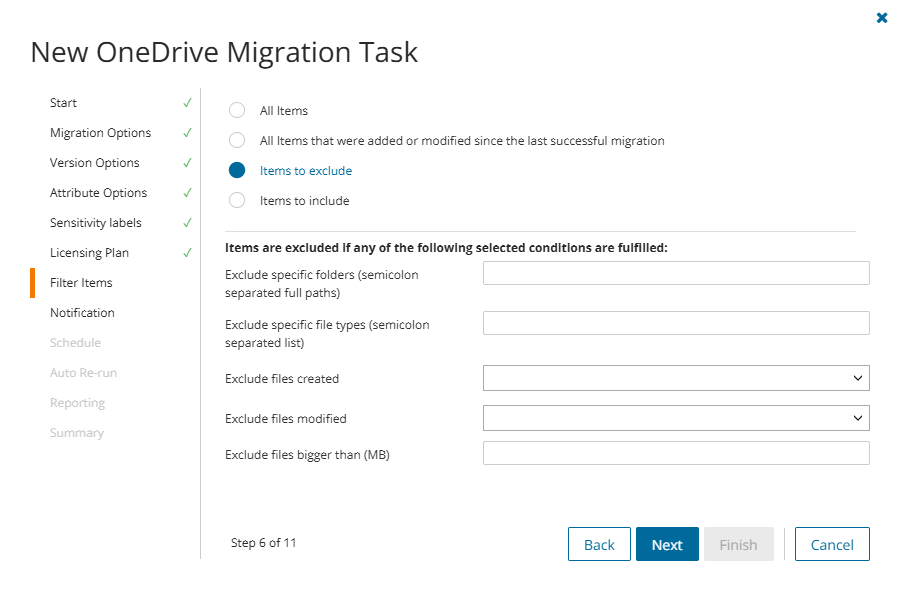
- Set up filters as described below:
- All items - select this option to ignore filters. This is the default option and all OneDrive Content for the selected account will be migrated.
- All items that were added or modified since the last successful migration - select this option to migrate items that were added or modified in the source since the last successful migration. The migration service will check the Last Successful Run attribute and migrate every item added or modified in the source. If the OneDrive has not been successfully migrated before, all items will be migrated.
- Items to exclude - select this filter option to exclude files and folders from the migration. Then specify the filter criteria. Items are excluded if any of the following criteria are fulfilled:
- Exclude specific folders- provide a semicolon-separated list of relative paths to folders that you want to skip. You can use slash or backslash. If it is convenient for you, use spaces after semicolons, e.g., filteredfolder; somefolder/subfolder
- Exclude specific file types - provide a semicolon-separated list of file extensions. The values are not case sensitive. You can use spaces and dots, e.g., .exe; dll; bat; doc; pdf
- Exclude files created
- select Before from the dropdown. Then click in the date field that appears to open the date picker and select a date. Files created before this date will not be migrated.
- select After from the dropdown and then click in the date field that appears to open the date picker and select a date. Files created after this date will not be migrated.
- Exclude files modified
- select Before from the dropdown. Then click in the date field that appears to open the date picker and select a date. Files modified before this date will not be migrated.
- select After from the dropdown. Then click in the date field that appears to open the date picker and select a date. Files modified after this date will not be migrated.
- Exclude files bigger than (MB) - enter a numeric value. The maximum value is 1000 MB. Only integer values are supported.
- Items to include - select this filter option to include files and folders in the migration. Then specify at least one filter criteria. Items are included if any of the following criteria are fulfilled:
- Include specific folders- provide a semicolon-separated list of relative paths to folders that you want to include. You can use slash or backslash. If it is convenient for you, use spaces after semicolons, e.g., filteredfolder; somefolder/subfolder
- Include specific file types - provide a semicolon-separated list of file extensions. The values are not case sensitive. You can use spaces and dots, e.g., .exe; dll; BAT
- Include files created
- select Before from the dropdown. Then click in the date field that appears to open the date picker and select a date. Files created before this date will be migrated.
- select After from the dropdown. Then click in the date field that appears to open the date picker and select a date. Files created after this date will be migrated.
- Include files modified
- select Before from the dropdown. Then click in the date field that appears to open the date picker and select a date. Files modified before this date will be migrated.
- select After from the dropdown. Then click in the date field that appears to open the date picker and select a date. Files modified after this date will be migrated.
- Include files bigger than (MB) - enter a numeric value. The maximum value is 1000 MB. Only integer values are supported.
- Click Next.
- Notification
- Send notification email once the task is completed - select this option to send a notification email when a discovery task completes.
- Only in a case of failure - Select this option to send the email if the discovery task fails to complete successfully.
- Recipients - enter the email address of the recipients of this email. You can specify multiple recipient email addresses separated by semicolon.
- Click Next.
- Schedule
- Choose from one of three options to schedule the task. The scheduler will be activated only after you complete the task wizard.
- Run now - task runs immediately.
- Run later - task must be started manually.
- Schedule - task will be started at a future date and time entered in the corresponding calendar field.
- Priority - select a priority from the dropdown for the objects scheduled for migration with this task . Values are: Highest, High, Medium, Low and Lowest. The default priority is Medium. If the system is busy, the objects are queued (Migration state = Queued). When the system accepts new migration work, objects are taken from the queue based on the assigned priority and age in the queue.
- Click Next.
- Auto rerun
- Auto re-run task if target user(s) are missing any files or folders - Select this option to rerun the migration task for files or folders that failed to migrate on the first run. The migration task will auto rerun once only. Failure of the files to migrate the first time could be because of intermittent network issues or throttling. We recommend that this setting remains selected.
This setting is enabled but read-only if the Migrate permissions in the Auto rerun task option is selected in Attribute Options. Auto re-run is not available if an alternate target migration folder has been specified in the Migration Options step or item filters have been configured in Filter Items step.
The migration service will issue an event warning for all files that fail to migrate. You can also check the batches for how many files failed to migrate.
- Click Next.
- Reporting
- Generate detailed report of migration errors - select this option to generate a migration error report when you run the OneDrive Migration Task.
You can download the report from the Reports tab of the Accounts and User Data migration workspace by clicking the Download link in the Error Log column. If there are no migration errors, a download link is not available. Error reports are retained for 30 days. After 30 days the download link is replaced with the label Expired and you can no longer download the report. For more information about error reports, see Reports.
- Generate AI summary - select this option to generate an AI summary of the task, as well as each object in the task.
|

|
NOTE: If this is the first time you have selected this option, the Quest Policies prompt appears. Read the Quest AI Terms of use and click Accept to proceed. This s a one-time acceptance prompt and your acceptance covers all migration tasks that support the AI migration assistant. |
- Summary
- Save task settings as a migration template - select this option to save the settings in this wizard as a reusable migration template.
- Migration Template Name - specify a name for the template. If you have changed the settings of a preselected template, specify the same template name to apply the changes to the template when you complete the wizard.
- Verify the task specifications as described below:
- Name - name of the task. You can specify a custom name. The default name is OneDrive Migration Task.
- Source tenant - name of the tenant where the statistics will be collected.
- Target tenant - name of the target tenant in this project.
- Scheduled start - date and time when the task will start. Now indicates that the task will start immediately.
- Priority - the priority of this task.
- File migration - migration action when a file is migrated.
- Versions to migrate - options to migrate the version history.
- Account to display - account name that will be displayed in the Created by and Modified by properties of migrated content:
- Alternative migration location - default is the root folder or an alternate target migration folder
- Sharing permissions - how sharing permissions will be transferred to the target users.
- Auto-rerun - option to rerun the migration task for files or folders that failed to migrate on the first run.
- Sensitivity labels - indicates how sensitivity labels should be processed. Valid settings are: Do not process labels, Match and apply corresponding labels to documents migrated to the target, and Remove sensitivity labels from documents migrated to the target.
- Reporting - option to collect and retain data for report generation.
- Click Back to change configurations if necessary or click Finish to save and start the task as scheduled.
Tracking the progress of the migration task
While the OneDrive Migration Task is running, click Assessment to track the progress of the migration task.

The following summary reports are available and described below.
OneDrive Users
The Users figure at the top of the OneDrive users pane reports on the total number of OneDrive users to migrate.
Account migration and matching reports on the number of OneDrive users matched and not matched.
OneDrive provision in target reports on the number of provisioned users.
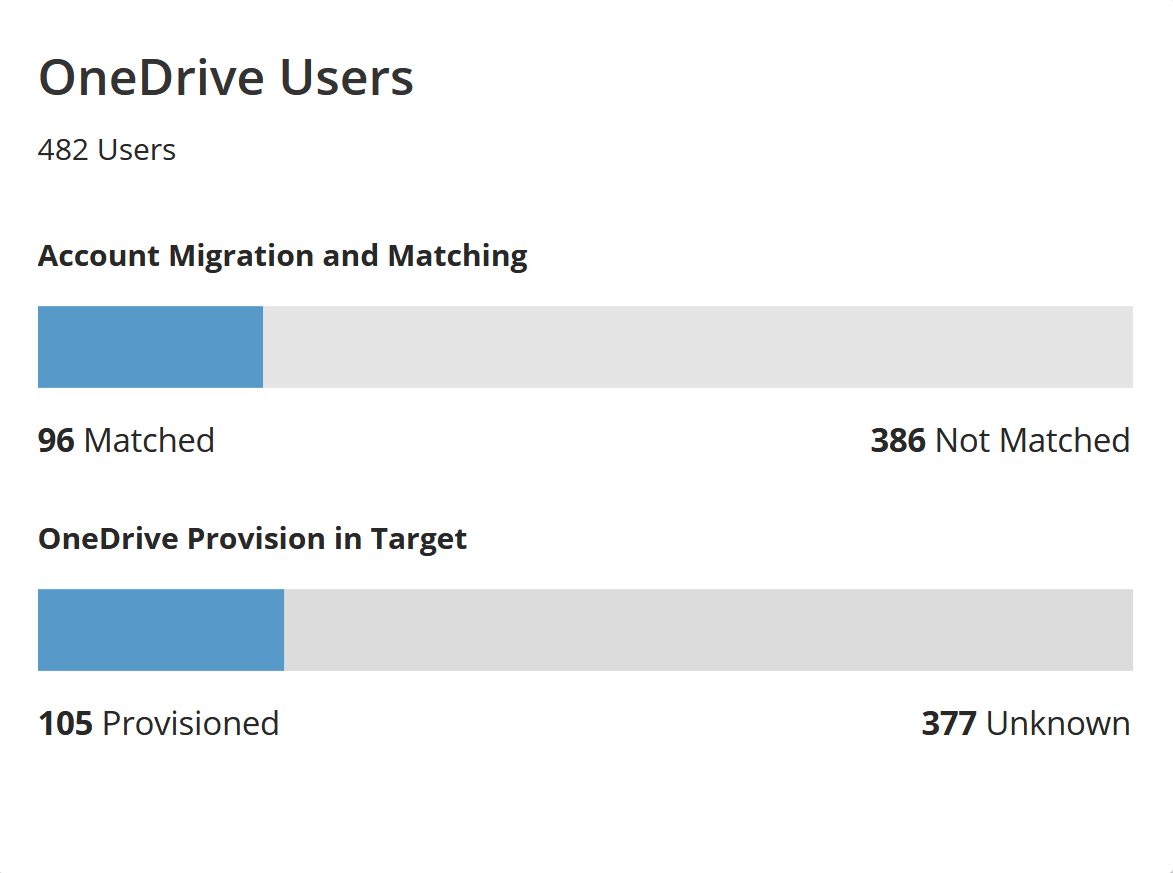
Migration Progress
The migration progress pane reports on the status of the migration of OneDrive users. It is updated in real time.
| Last Run Status |
This data relates to the Last Run Status column on the List View tab. Show data from the last run status: new, in progress, completed, failed, stopped. |
|
Progress of Started Users |
Started Users = The users listed on the List View tab with Migration Progress % greater than zero.
The bar chart shows the Migration Progress % for users. It shows how many users have Migration Progress % at fewer than 50%, 50% to 95%, 95% to 99%, and 100%. For example, if the diagram shows 63 users at 100% then 63 users have Migration Progress % value of 100%.
How is Migration Progress % calculated? It is calculated as a ratio of the number of target items to the number of source items. If 10 items have migrated to the target and there are 100 items to be migrated on the source then the ratio for that user Migration Progress % is 10%. |
| Average % for started users |
This is the average Migration Progress % value for users on the List View. |

Migration Statistics
The migration statistics pane reports on statistics recorded for the last 14 days.
- Total migration file size for entire project (last 14 days)
- Total migration file count for entire project (last 14 days)
Dependent on the scope of the file migration the content of OneDrive storage is transferred in batches that can be submitted for processing to OneDrive at the same time to be processed concurrently, it can take a while for OneDrive to complete processing of submitted batches. Refer also to the Events tab while the migration task is running.
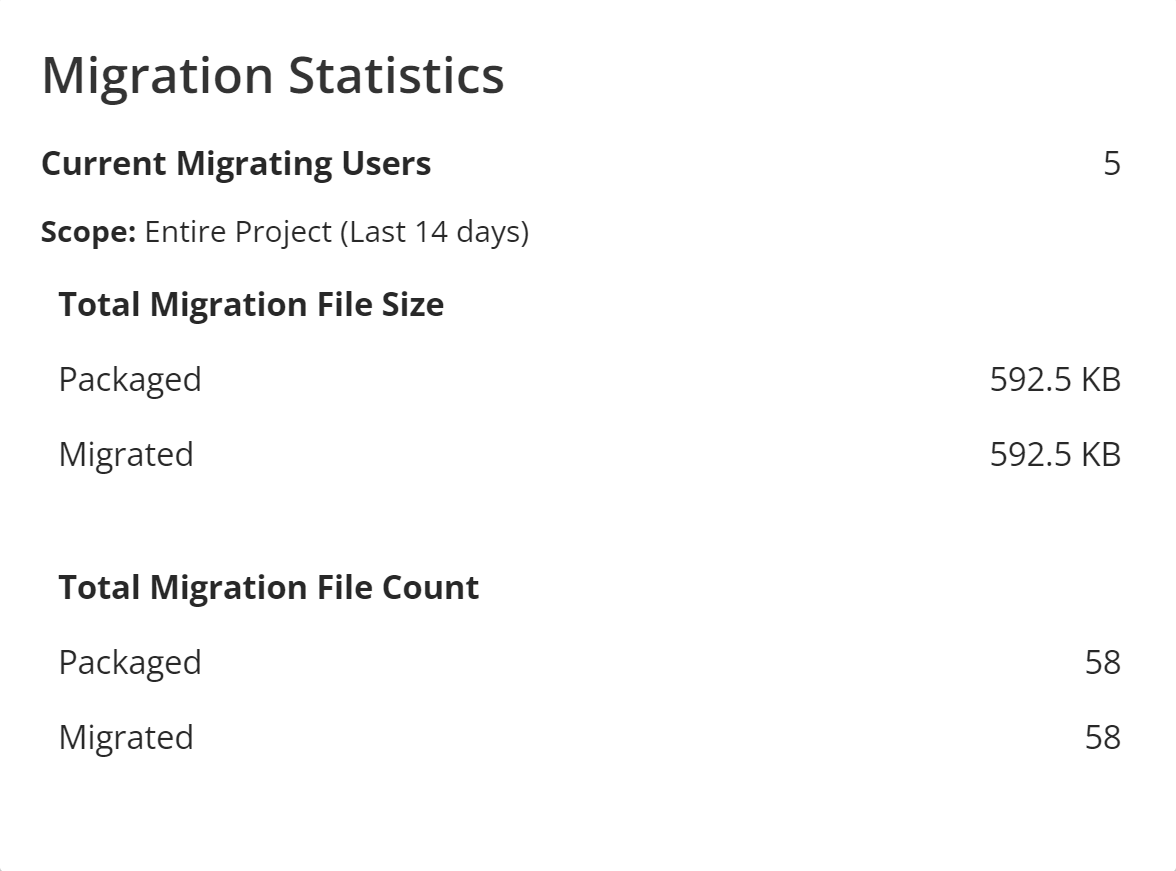
Viewing the report
- Open the Tasks tab.
- Select the OneDrive Reporting Task (or your custom name) that you want to review.
- In the task detail pane that opens click Events (number).
- Select the event with the description: Link to download the report is in the Details pane. Report link is active for 1 hour.
- Click the report link in the detail pane.
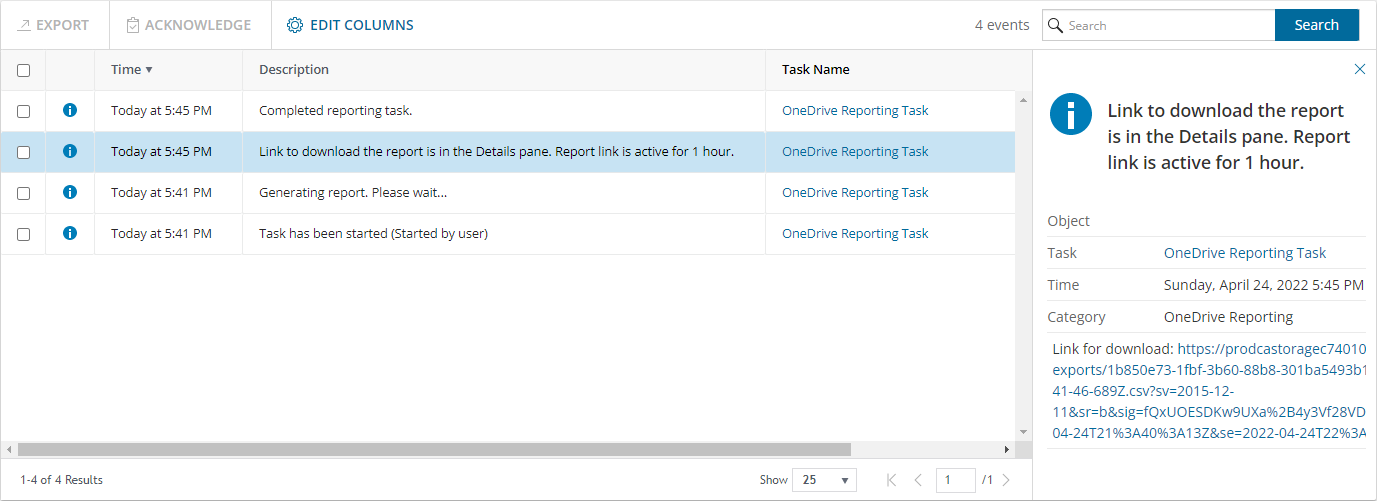
- You can rerun the OneDrive Reporting Task after 1 hour to generate another report, and follow the same steps described here to view the report.
Reviewing the OneDrive Migration Task
You can track a task's progress from the Tasks tab, view the summary on the Dashboard or monitor alerts and notifications in Events.

- Open the Tasks tab.
- Select the OneDrive migration task that you want to review.
- In the task detail pane that opens, the information presented is as described below:
- Type - Type of the task. The type is Migrate Mail.
- Created - Date and time when the task was created.
- Modified - Date and time when the task was last updated.
- Status - Current status of the task.
- Last Operation - The action that was most recently performed in this task.
- Schedule - Date and time when the task started. Now indicates that the task started immediately after the task was created.
- Accounts (number) - The number of OneDrive accounts that were selected for migration and the number of accounts passing through the various states.
- Events (number) - Number indicates the count of events that the task encountered. The icon values indicate the type of the events and the event count for each type.
-
- View AI Summary - This link is available if you opted for the AI feature in the organization you created (see Organizations and Regions), and the task is a migration task that supports the AI migration assistant and you selected the Generate AI summary option in the Reporting step of the migration wizard. Click this link after the task has completed, to view the AI-generated migration summary.
|

|
NOTE: The View AI Summary link may take a while to appear depending on the volume of tasks and objects being migrated. If this is the first time you have selected this option, the Quest Policies prompt appears. Read the Quest AI Terms of use and click Accept to proceed. This s a one-time acceptance prompt and your acceptance covers all migration tasks that support the AI migration assistant. |
- Copy Diagnostics - click this link to copy relevant task properties that you can paste in a text file and use it to troubleshoot the task if necessary.





















